
Animals that start with G include mammals such as the giant otter, giraffe, grey seal and gorilla; birds such as the galah and gyrfalcon; reptiles such as the Gaboon viper and Gila monster; and invertebrates such as the giant clam and goliath beetle.
On this page is a list containing these and many other interesting animals beginning with G, together with pictures and facts on each species.
Below each animal you’ll find links that you can follow for further information, pictures and videos.
Included in this list are individual species (e.g., the gray seal) and groups of animals (e.g., geese) whose names begin with G.
The scientific name and conservation status are provided for each of the individual species.
Index

Scroll down to see pictures and facts on all of the animals, or use the index below to go directly to a particular animal.
List Of Animals Beginning With G
- Gaboon Viper
- Galah
- Galápagos Penguin
- Garter Snake
- Gaur (Indian Bison)
- Gentoo Penguin
- Geoffroy’s Tamarin
- Gerbil
- German Shepherd
- Gharial
- Giant Clam
- Giant Otter
- Giant Panda
- Gibbon
- Gila Monster
- Giraffe
- Goblin Shark
- Golden Lion Tamarin
- Golden Masked Owl
- Golden Oriole
- Golden Poison Frog
- Golden Retriever
- Goldfish
- Goliath Beetle
- Goliath Birdeater
- Goose
- Gopher
- Gorilla
- Grasshopper
- Gray Fox
- Gray Reef Shark
- Gray Seal
- Great Blue Heron
- Great Dane
- Great Hammerhead Shark
- Great White Shark
- Greater Flamingo
- Green Anaconda
- Greenland Shark
- Grey Mouse Lemur
- Grizzly Bear
- Guinea Pig
- Gyrfalcon
You can find animals beginning with other letters by clicking on the squares below…
Gaboon Viper
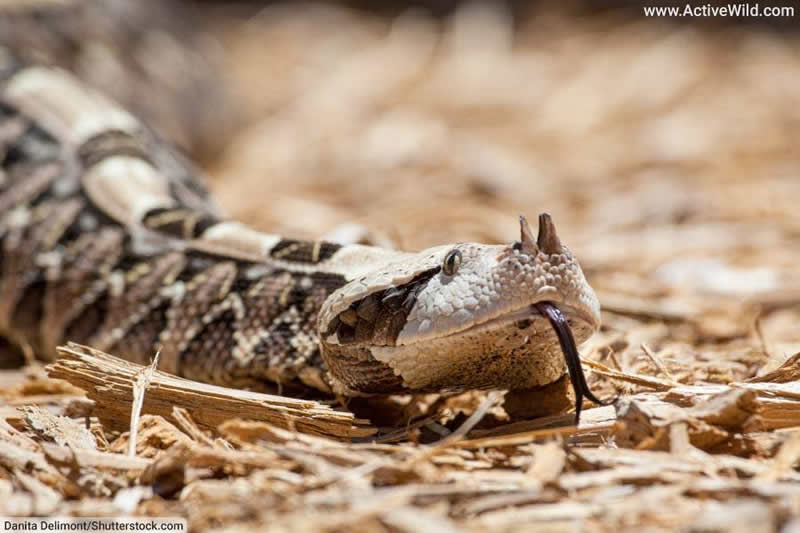
- Scientific name: Bitis gabonica
- Type of animal: Reptile
- Family: Viperidae
- Where found: Sub-Saharan Africa
- Conservation status: Vulnerable
The Gaboon Viper is a highly-venomous African snake found in rainforests and savannas south of the Sahara Desert.
The species has the longest fangs of any venomous snake. These lethal weapons reach lengths of up to 5 cm / 2 in., and are used by the snake to inject venom into its prey, which consists of small to medium-sized mammals and birds.
Although the Gaboon Viper’s venom is deadly to humans, the snake is not particularly aggressive and will only attack when provoked.
With an average length of 1.2 meters / 3.9 feet, the Gaboon viper is the largest member of the Viperidae family. It is not uncommon for this snake to reach 2.2 m / 7.2 feet and to weigh over 10 kg / 22 lbs.
The Gaboon viper is viviparous (i.e., it gives birth to live young). Females give birth to around 35 offspring after a 7-month gestation period. The young snakes are independent from the moment they are born and receive no parental care.
The Gaboon viper has no known predators. Even monitor lizards known to feed on venomous snakes will stay away from this apex predator.
Discover More with Active Wild
Discover more amazing snakes on this page: Types of Snakes
Discover more about snakes on this page: Fun Facts on Snakes
Become a reptile expert: Reptiles – The Ultimate Guide
Galah
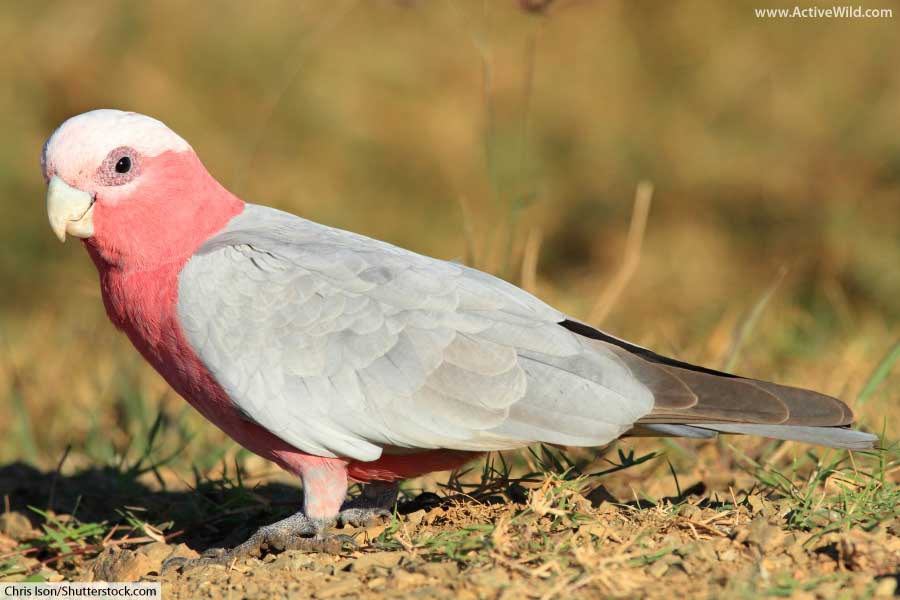
- Scientific name: Eolophus roseicapilla
- Type of animal: Bird
- Family: Cacatuidae
- Where found: Australia
- Conservation status: Least Concern
The galah is a cockatoo found throughout Australia. It is one of 21 species in the cockatoo family, Cacatuidae. The cockatoo family is part of a larger group of birds, the order Psittaciformes, which is home to all parrots.
With its distinctive pink chest and face, and gray wings and tail, the galah is a familiar sight in Australia, where it is fairly common in a variety of habitats, including towns and cities.
In Australia, if you call someone a ‘galah’, you’re calling them an idiot! This is somewhat unfair on the galah, as parrots are known for their high intelligence.
Discover More with Active Wild
You can see more Australian birds on this page: Australian Birds with Pictures & Facts
Find out more about birds on this page: Birds – The Ultimate Guide
Galápagos Penguin
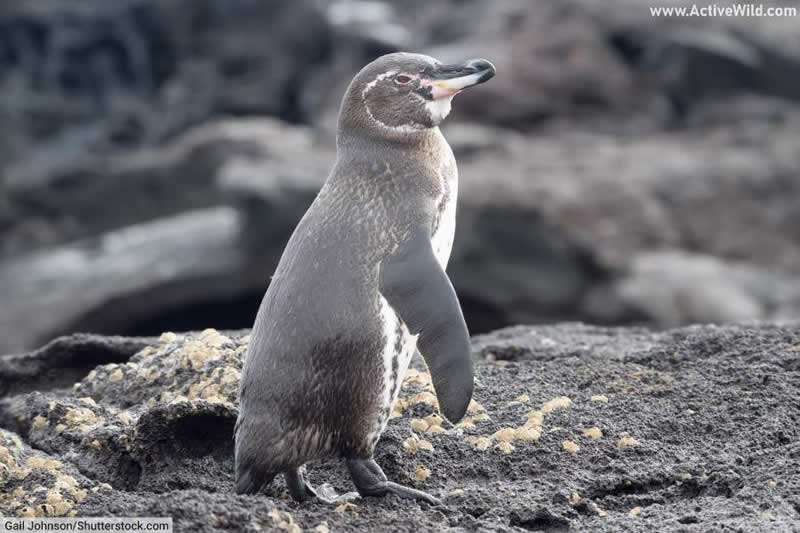
- Scientific name: Spheniscus mendiculus
- Type of animal: Bird
- Family: Spheniscidae
- Where found: Galápagos
- Conservation status: Endangered
The Galápagos penguin is one of the smallest species of penguin, and the only penguin species found north of the equator. The species is endemic to the Galápagos Islands of Ecuador.
This small penguin is currently endangered due to its very limited range and threats from both human disturbance and climate change.
The Galápagos penguin is entirely carnivorous, feeding exclusively on small fish and crustaceans. It hunts in groups, chasing its prey underwater before capturing it from below.
The Galápagos penguin forms monogamous pairs that breed all year round. Mortality is high among individuals of all ages due to predation by sharks, fur seals and hawks, as well as by introduced predators such as dogs, cats and rats.
Discover More with Active Wild
You can see EVERY species of penguin on this page: Types of Penguins with Pictures
You can find out more about penguins here: Penguin Facts
Garter Snake
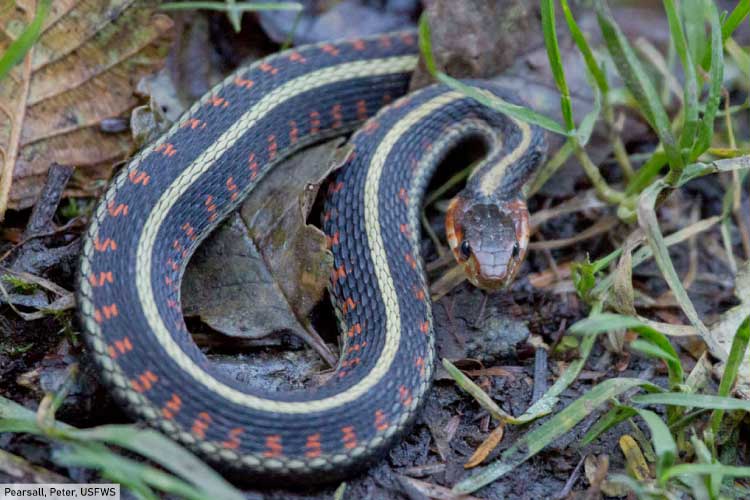
- Type of animal: Reptile
- Family: Natricidae (Colubridae)
- Where found: North America
- Conservation status: Least Concern
There are 35 species of garter snake, all of which are found in North America (including Central America). Together, they make up the genus Thamnophis, which is part of the family Natricidae.
Garter snakes are some of the commonest snakes in North America. Their success is due in part to their great adaptability; garter snakes are able to live in a wide range of habitats.
Once thought to be non-venomous, garter snakes are now known to have mild toxins in their saliva. This causes paralysis in their prey, making it easier to swallow. These toxins are harmless to humans.
If threatened, garter snakes emit a foul-smelling secretion from their anal glands.
Garter snakes in Canada are known to hibernate underground in large numbers, emerging together in the spring.
Discover More with Active Wild
Discover more amazing snakes on this page: Types of Snakes
Discover more about snakes on this page: Fun Facts on Snakes
Become a reptile expert: Reptiles – The Ultimate Guide
Gaur (Indian Bison)
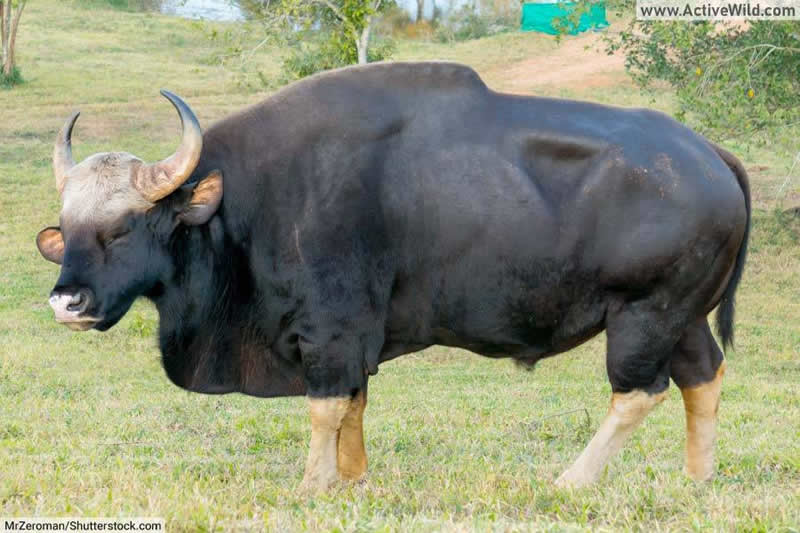
- Scientific name: Bos gaurus
- Type of animal: Mammal
- Family: Bovidae
- Where found: Asia
- Conservation status: Vulnerable
The gaur is a large ungulate (hoofed mammal) found in forests in southern Asia. Weighing up to 1,500 kg / 3,306.93 lb., and standing over 2 m (6.5 ft.) at the shoulder, the gaur is the largest living wild cattle species.
Like all bovids, the gaur is herbivorous. It mainly feeds on grasses.
Hunting is the main threat to these vulnerable animals. Gaurs are hunted both for their meat and for their curved horns, which are present on both males and females.
Discover More with Active Wild
You can see more Asian animals on this page: Asian Animals List with Pictures & Facts
Discover more horned animals on this page: Animals With Horns – Pictures & Facts
Gentoo Penguin
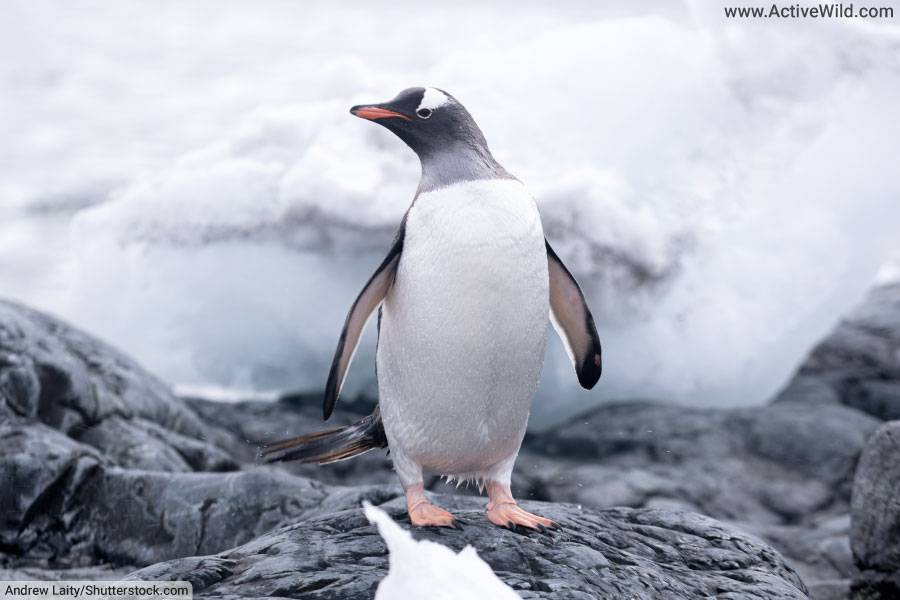
- Scientific name: Pygoscelis papua
- Type of animal: Bird
- Family: Spheniscidae
- Where found: Antarctica, Subantarctic islands
- Conservation status: Least Concern
The Gentoo penguin is the third-largest penguin species, and the fastest underwater bird; the species is capable of reaching speeds of 36 km / 22.4 miles per hour when hunting. Like all penguin species, the gentoo is carnivorous, feeding on fish, krill and crustaceans.
As well as being found on the Antarctic Peninsula of Antarctica, the gentoo penguin is found on several Antarctic and Subantarctic islands between 45° and 65° S.
This penguin has the typical “countershading” coloration shared by all penguins. This provides camouflage from both predators and prey. The white undersides match the sky when the penguin is viewed from below, while their black dorsal side blends in with the ocean floor when the penguin is viewed from above.
The Gentoo penguin is sexually dimorphic, with males being larger than females. The breeding season lasts from June until November, and the Gentoo forms monogamous pairs each season. Both sexes take turns incubating their eggs and caring for their young.
Discover More with Active Wild
You can see EVERY species of penguin on this page: Types of Penguins with Pictures
You can find out more about penguins here: Penguin Facts
Discover the penguins of the world’s coldest and least-inhabited continent: Antarctic Penguins
Geoffroy’s Tamarin
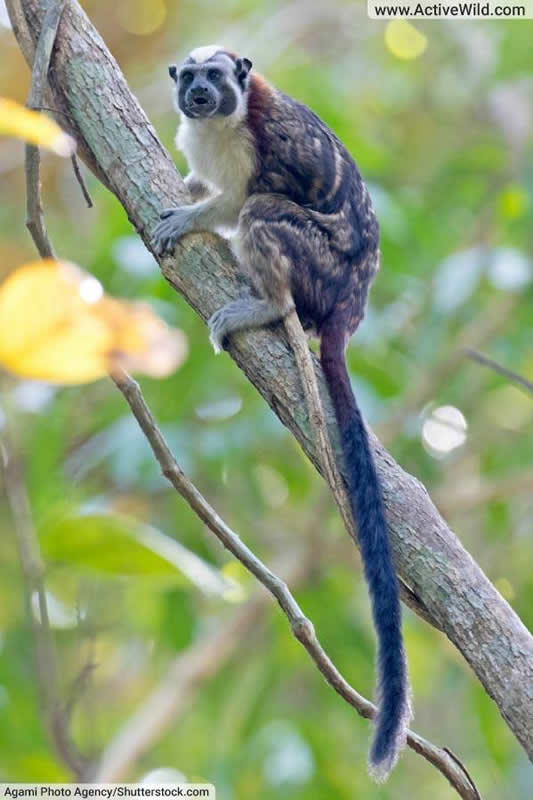
- Scientific name: Saguinus geoffroyi
- Type of animal: Mammal
- Family: Callitrichidae
- Where found: Colombia and Panama
- Conservation status: Near Threatened
Geoffroy’s tamarin is a small monkey found in forests in Panama and northern Colombia. It is the smallest primate found in Panama, with an average body length of 20 – 29 cm / 7.9 – 11.4 in. and a tail length of 31 – 42 cm / 12.2 – 16.5 in. Females, with an average weight of 0.5 kg / 1.1 lbs., are slightly larger than males.
This small primate moves around in family groups. Females usually give birth to twins, and the father is very involved in their care, carrying and grooming the infants. Other members of the group, such as older siblings, also participate in the care and protection of the young.
Geoffroy’s tamarin is omnivorous with a diet consisting mainly of fruits, insects, reptiles and eggs. When fruit is not available, the species will also consume nectar and tree sap.
Discover More with Active Wild
Find out more about monkeys on this page: Monkeys – The Ultimate Guide
See more monkeys on this page: Types of Monkeys with Pictures & Facts
Discover more about primates on this page: Primates – The Ultimate Guide
Gerbil
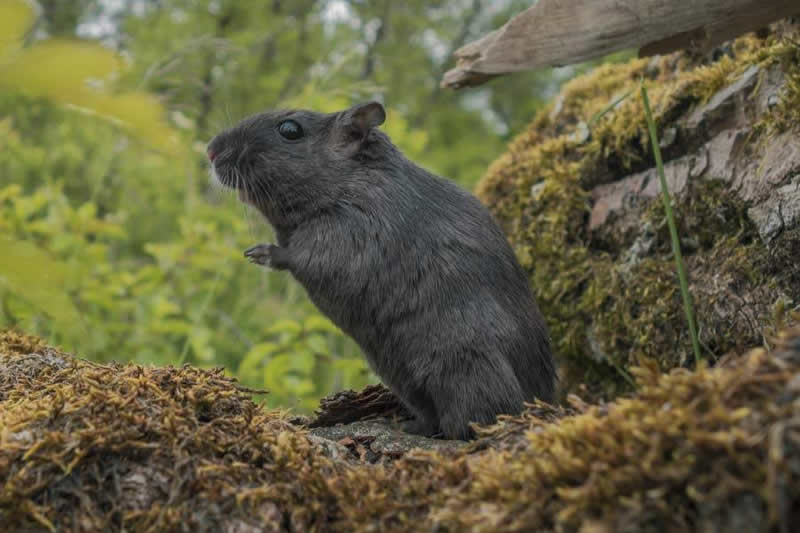
- Type of animal: Mammal
- Order: Rodentia
- Where found: Africa, Asia and Europe
Gerbils are rodents belonging to the subfamily Gerbillinae. They are highly adapted to life in an arid environment. Most gerbil species are diurnal (active during the day) and excellent jumpers, with some of the most athletic species capable of leaping up to 3.5 m / 11.6 feet.
There are 111 gerbil species divided into 16 genera. The largest is the genus Gerbillus, known as the “northern pygmy gerbils”, which comprises 55 different species.
The largest gerbil species is the “Great Gerbil” (Rhombomys opimus) which weighs 285 gr / 10 oz. on average, and has a body length of up to 33 cm / 13 in., of which its tail makes up 25 – 50%.
The smallest gerbil species is the “Pouched Gerbil” (Desmodilliscus braueri), with a weight of 6 – 14 gr / 0.2 – 0.5 oz. and a length of 4 – 8 cm / 1.6 – 3.1 in.
Gerbils are popular pets in many parts of the world. The two gerbil species most commonly kept as pets are the Mongolian gerbil (Meriones unguiculatus) and the fat-tailed gerbil (Pachyuromys duprasi).
Discover More with Active Wild
You can find out more about rodents on this page: Rodents – The Ultimate Guide
You can see more desert animals on this page: Desert Animals List with Pictures & Facts
German Shepherd

- Scientific name: Canis lupus familiaris
- Type of animal: Mammal
- Family: Canidae
- Where found: Worldwide
- Conservation status: Domestic
Also known as the Alsatian, the German shepherd is a large breed of dog known for its intelligence and strength.
Originally bred for herding sheep, the German shepherd – due to its size and ability to learn tasks – is used by the police and military of several countries.
Discover More with Active Wild
You can find out more about dogs on this page: Dog Facts
Discover every species in the dog family on this page: Dog Species List with Pictures & Facts
Gharial
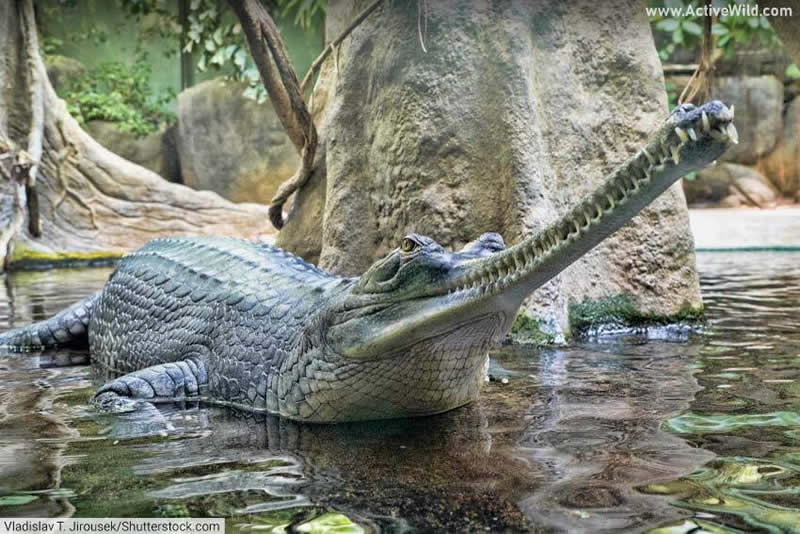
- Scientific name: Gavialis gangeticus
- Type of animal: Reptile
- Family: Gavialidae
- Where found: Asia
- Conservation status: Critically Endangered
The gharial (also known as the gavial) is a predatory, semiaquatic reptile found in the Indian subcontinent. As a member of the order Crocodilia, it is related to crocodiles, alligators and caimans.
The gharial can be distinguished from other crocodilians by its long, thin snout. This is an adaptation for catching fish, which form the majority of the reptile’s diet.
With a world population of around 600 adults, the gharial is critically endangered. The main threat to the species are dams and barrages built across the waterways in which the species is found.
Discover More with Active Wild
Discover more about the gharial on this page: Gharial Facts
You can see more Asian animals on this page: Asian Animals List with Pictures & Facts
Giant Clam
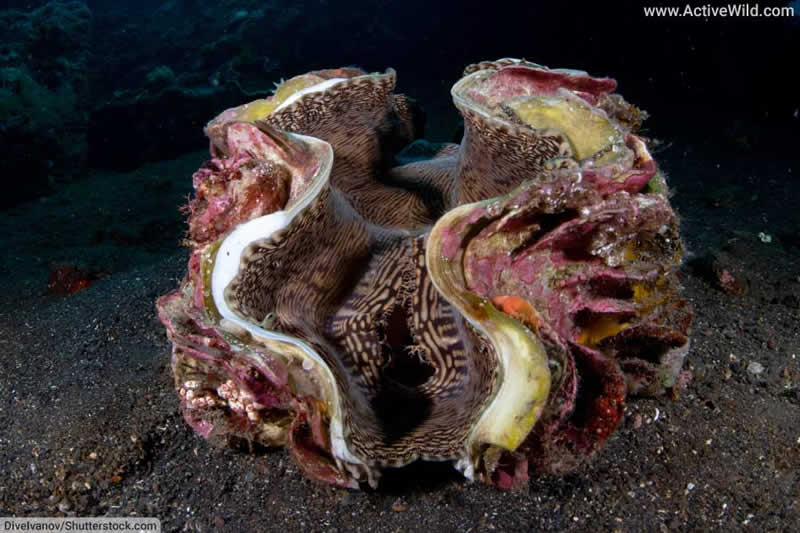
- Scientific name: Tridacna gigas
- Type of animal: Bivalve
- Family: Cardiidae
- Where found: Indian and Pacific oceans
- Conservation status: Vulnerable
The Giant Clam is the world’s largest bivalve mollusk. Its shell that can reach widths of up to 1.5 m / 4ft 11in., and individuals can weigh more than 250 kg / 551 lbs.
As an adult, the giant clam attaches itself to the seabed and is sessile (unable to move). Unable to flee if threatened, the only defense mechanism the mollusk has is to retract its mantle and close its shell.
Despite being sessile, the Giant Clam reproduces sexually via a mechanism called “broadcast spawning” in which eggs and sperm are emitted into the sea. Fertilization occurs by chance in the open ocean.
After hatching, the larvae are free-swimming for around a week. After finding a suitable habitat, they affix themselves to a surface from which they will never move.
Although the giant clam uses a siphon to filter out water and consume plankton and other microorganisms, most of its sustenance comes from the symbiotic relationship it has with the billions of photosynthetic algae that live in its mantle.
Discover More with Active Wild
Discover more amazing ocean animals on this page: Ocean Animals
Giant Otter
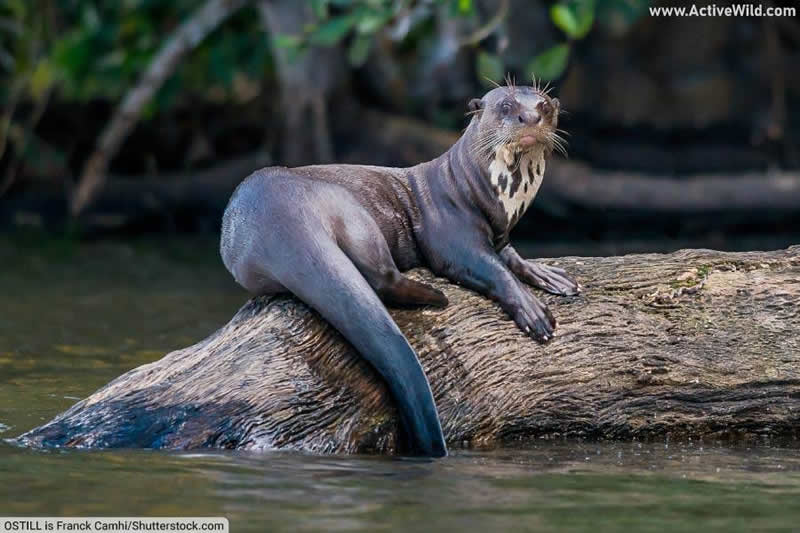
- Scientific name: Pteronura brasiliensis
- Type of animal: Mammal
- Family: Mustelidae
- Where found: South America
- Conservation status: Endangered
Reaching a length of up to 1.8 m / 5.91 ft., the giant otter is the longest member of the weasel family Mustelidae, but not the heaviest (the heaviest mustelid is the sea otter).
The giant otter lives in Brazil, where it is found both in the Amazon Rainforest and the Pantanal (a large tropical wetland area). Like all otters, the giant otter is semiaquatic. Its diet consists mainly of fish.
Discover More with Active Wild
You can see more rainforest animals on this page: Rainforest Animals List with Pictures & Facts
Giant Panda
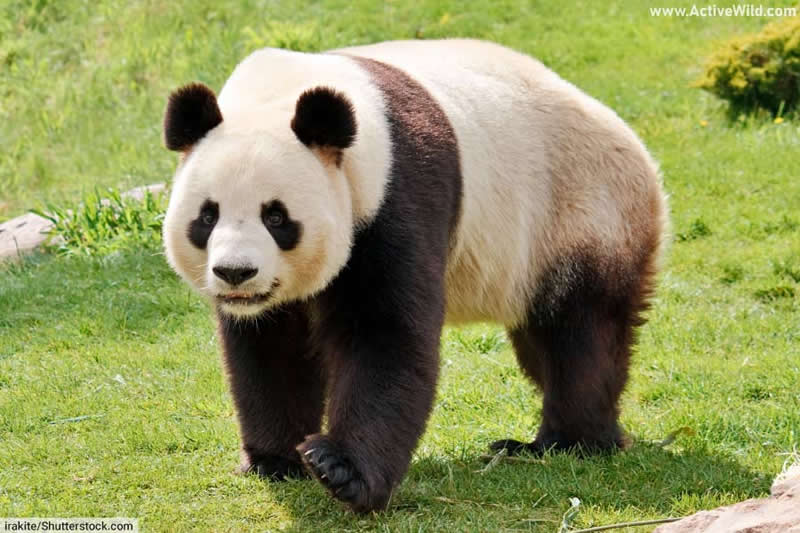
See Animals That Start With P – Panda
Discover More with Active Wild
Discover more about the giant panda on this page: Panda Facts
You can see more Asian animals on this page: Asian Animals List with Pictures & Facts
Gibbon

- Type of animal: Mammal
- Family: Hylobatidae
- Where found: Asia
- Conservation status: Various
Gibbons comprise the family Hylobatidae, and are also known as the “lesser apes”. (Hylobatidae is one of the two ape families, the other being Hominidae (the “great apes”).
Gibbons are masters at moving through the trees, and have exceptional climbing, swinging and jumping abilities.
There are 18 species of gibbon. They are found in the rainforests of Southeast Asia. Well-known gibbon species include the siamang (the largest gibbon) and the lar gibbon, both of which are endangered.
Discover More with Active Wild
Discover more about primates on this page: Primates – The Ultimate Guide
You can see more Asian animals on this page: Asian Animals List with Pictures & Facts
Gila Monster
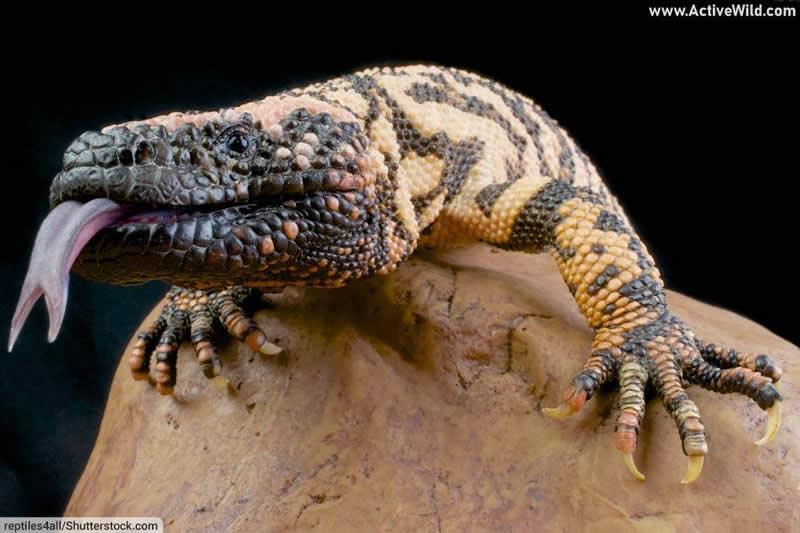
- Scientific name: Heloderma suspectum
- Type of animal: Reptile
- Family: Helodermatidae
- Where found: North America
- Conservation status: Near Threatened
The Gila monster is the largest lizard native to the USA (although introduced species such as iguanas are larger). It is one of two venomous lizards (the other being the closely-related Mexican beaded lizard).
The Gila monster is found in the southwestern United States and Mexico. It lives in scrubland and desert habitats. It hunts by smell and mainly eats bird and reptile eggs.
Discover More with Active Wild
You can find out more about the Gila monster on this page: Gila Monster Facts
Discover more lizards on this page: Types of Lizards
Giraffe
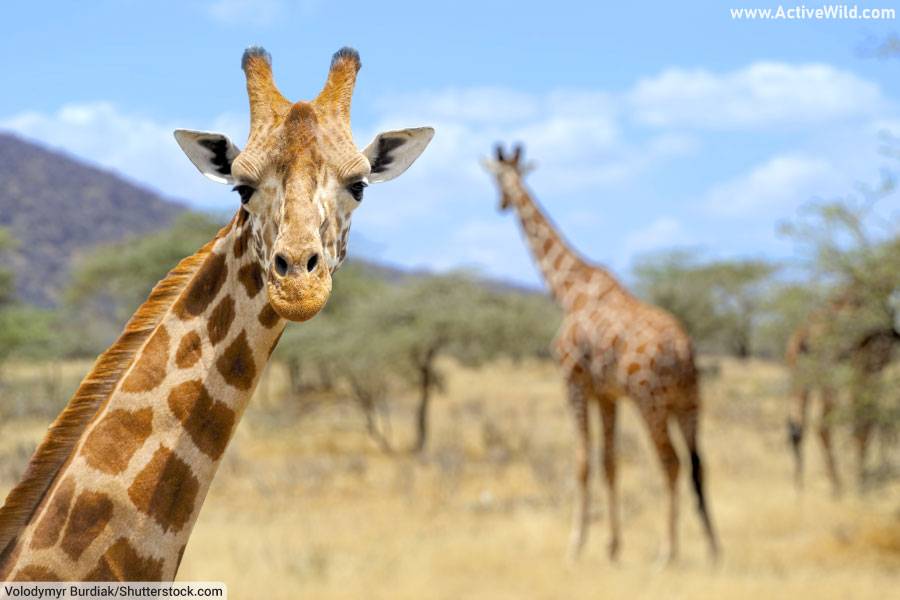
- Scientific name: Giraffa camelopardalis
- Type of animal: Mammal
- Family: Giraffidae
- Where found: Africa
- Conservation status: Vulnerable
No list of animals that start with G would be complete without the giraffe, the world’s tallest animal. Large male giraffes can obtain heights of 5.7 m (18.7 ft). The species’ great height allows it to reach foliage inaccessible to smaller animals.
Each of the nine subspecies (types) of giraffe is found in a separate region in Africa. A giraffe’s horns are known as “ossicones”.
The giraffe’s closest relative (and the only other species in the family Giraffidae), is the okapi.
Discover More with Active Wild
Discover more about the giraffe on this page: Giraffe Facts
You can see more African animals on this page: African Animals List with Pictures and Facts
Goblin Shark
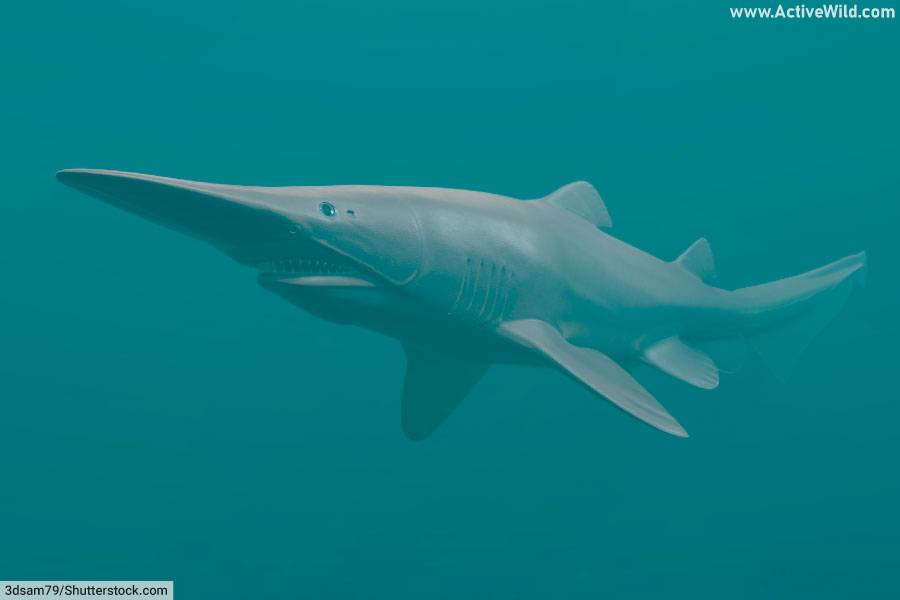
- Scientific name: Mitsukurina owstoni
- Type of animal: Fish
- Family: Mitsukurinidae
- Where found: Oceans worldwide
- Conservation status: Least Concern
The goblin shark is a deep-sea species of mackerel shark.
This bizarre looking fish has an elongated nose and jaws that can extend out of the mouth. Blood vessels close to the skin give the shark a pink color.
Most goblin sharks are around 13 ft. / 4 m in length, but large individuals are thought to exceed 20 ft. / 6 m.
Little is known about the lifestyle of this mysterious, rarely-encountered fish.
Discover More with Active Wild
You can see more sharks on this page: Types Of Sharks – Pictures & Facts
Learn more about sharks: Fun Facts on Sharks
Discover more amazing ocean animals on this page: Ocean Animals
Discover more about fish on this page: Fish – The Ultimate Guide
Golden Lion Tamarin
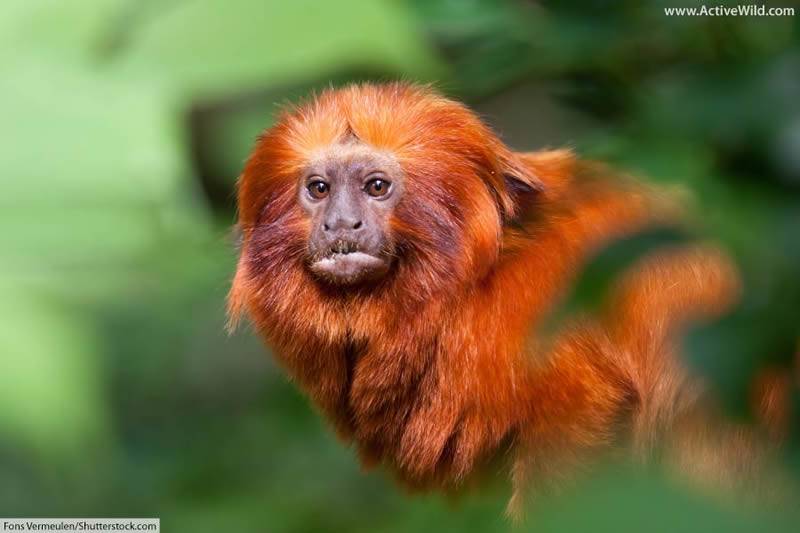
- Scientific name: Leontopithecus rosalia
- Type of animal: Mammal
- Family: Callitrichidae
- Where found: South America
- Conservation status: Endangered
The golden lion tamarin is an endangered monkey that lives in the Atlantic coastal forests in Brazil. The species’ name comes from its distinctive orange coat and the mane-like hair surrounding its face.
Massive deforestation has led to the golden lion tamarin’s range being reduced to just 2 to 5 percent of its original size.
Discover More with Active Wild
You can find out more about this endangered primate on this page: Golden Lion Tamarin Facts
Find out more about monkeys on this page: Monkeys – The Ultimate Guide
See more monkeys on this page: Types of Monkeys with Pictures & Facts
Discover more about primates on this page: Primates – The Ultimate Guide
Golden Masked Owl
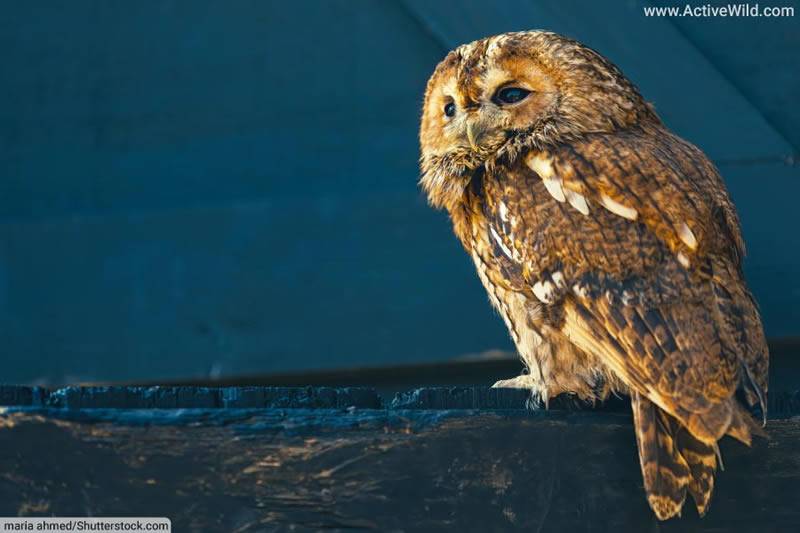
- Scientific name: Tyto aurantia
- Type of animal: Bird
- Family: Tytonidae
- Where found: New Britain Island, Papua New Guinea
- Conservation status: Vulnerable
The golden masked owl is the largest member of the genus Tyto, with adults reaching weights of 771 gr / 1.7 lbs. Owls of genus Tyto belong to the barn owl family, Tytonidae.
The golden masked owl is also known as the “New Britain barn owl”, “New Britain masked owl” and “Bismarck masked owl”.
Like all owl species, the golden masked owl is carnivorous. It feeds on small mammals, birds and insects.
This species is endemic to New Britain Island near New Guinea, and due to its very limited range the major threat it faces is habitat loss.
The golden masked owl is usually solitary, but during the breeding season it is commonly found in groups of up to 7 individuals.
Despite being known to live over 30 years, due to predation, the golden masked owl’s average lifespan in the wild is closer to 4 years.
Discover More with Active Wild
Find out more about birds on this page: Birds – The Ultimate Guide
Discover different types of birds on this page: Types of Birds with Pictures & Facts
Golden Oriole

- Scientific name: Oriolus oriolus
- Type of animal: Bird
- Family: Oriolidae
- Where found: Africa and Europe
- Conservation status: Least Concern
The Golden Oriole is a passerine (perching bird, or songbird) that spends most of its life in dense, leafy and tall trees, only coming down to the ground for brief seconds to catch prey.
A migrant, the golden oriole nests in Europe and northern Africa during the summer, and overwinters in Africa.
Like many birds, the Golden Oriole is sexually dimorphic, with the male having a striking yellow plumage with black on the wings, and the female being a pale olive green with dark brown markings and a whitish, streaked chest.
Both sexes are the same size, with an average length of 23 cm / 9 in., a wingspan of 45 cm / 17.7 in. and a weight of 50 – 80 gr / 1.8 – 2.8 oz.
For most of the year, the golden oriole is insectivorous, occasionally supplementing its diet with small mammals. However, as soon as the nesting season is over, the species becomes almost exclusively fructivorous, eating sugary fruits that allow it to build up a reserve of fat for the long flight back to Africa.
Discover More with Active Wild
Find out more about birds on this page: Birds – The Ultimate Guide
Discover different types of birds on this page: Types of Birds with Pictures & Facts
Golden Poison Frog
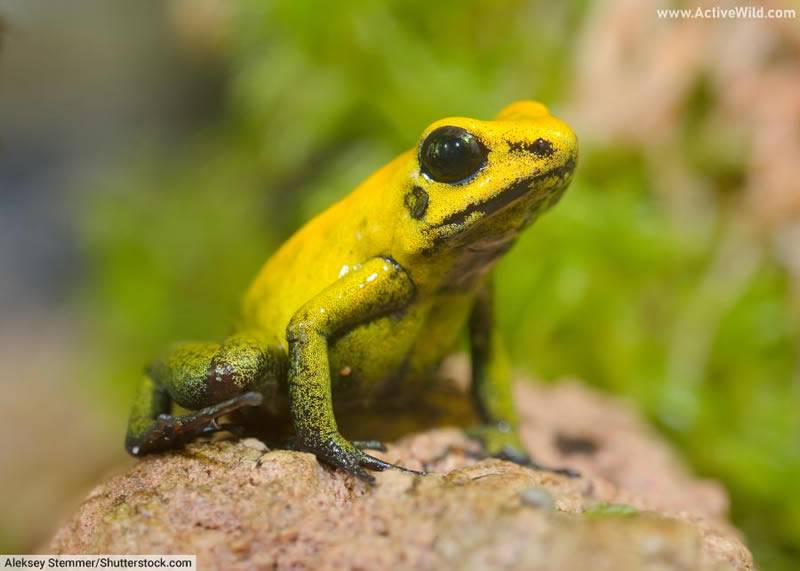
- Scientific name: Phyllobates terribilis
- Type of animal: Amphibian
- Family: Dendrobatidae
- Where found: South America
- Conservation status: Endangered
The golden poison frog is a small amphibian found only in rainforests in Colombia, South America.
Despite reaching a maximum length of just 6 cm / 2.36 in., this tiny amphibian is one of the most poisonous animals on earth. A single golden poison frog can carry enough poison to kill up to 20 men!
Discover More with Active Wild
Discover more about the golden poison frog on this page: Golden Poison Frog Facts
Find out more about amphibians on this page: Amphibians – The Ultimate Guide
You can see more amphibians on this page: Amphibians List with Pictures & Facts
You can see more rainforest animals on this page: Rainforest Animals List with Pictures & Facts
Golden Retriever

- Scientific name: Canis lupus familiaris
- Type of animal: Mammal
- Family: Canidae
- Where found: Worldwide
- Conservation status: Domestic
The golden retriever is a popular breed of dog that originated in Scotland during the 19th century. The breed’s ancestry includes the now extinct Tweed spaniel and the flat-coated retriever, with Irish setter, Labrador and bloodhound also contributing.
A medium to large dog, the golden retriever can be recognized by its characteristic long, golden hair. The breed weighs between 25 and 34 kg / 55 and 75 lbs., and stands 55 to 61 cm / 22 to 24 in. tall.
The golden retriever is a gun dog, originally bred to assist hunters retrieve prey from difficult spots, including water. The breed is strong, resilient and an excellent swimmer. Its coat has a double layer to keep it warm and waterproof.
The golden retriever is the fourth most popular pet dog breed in the USA, and the seventh in the UK.
Discover More with Active Wild
You can find out more about dogs on this page: Dog Facts
Discover every species in the dog family on this page: Dog Species List with Pictures & Facts
Goldfish
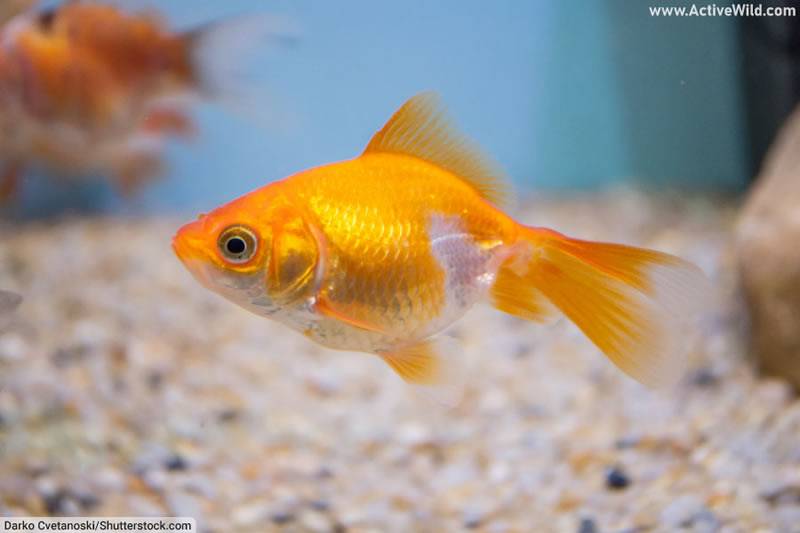
- Scientific name: Carassius auratus
- Type of animal: Fish
- Family: Cyprinidae
- Where found: Native to Asia; kept as a pet worldwide
- Conservation status: Least Concern
Originally found in East Asia, the goldfish is now found throughout the world due to its popularity as an easy-to-maintain aquarium fish.
Before gaining popularity as a pet, the goldfish was kept for food, and was originally grey or silver in color. The gold-colored mutations subsequently became sought-after as an ornamental fish.
Discover More with Active Wild
Discover more about fish on this page: Fish – The Ultimate Guide
You can see more fish on this page: Types of Fish with Pictures & Facts
You can see more Asian animals on this page: Asian Animals List with Pictures & Facts
Goliath Beetle
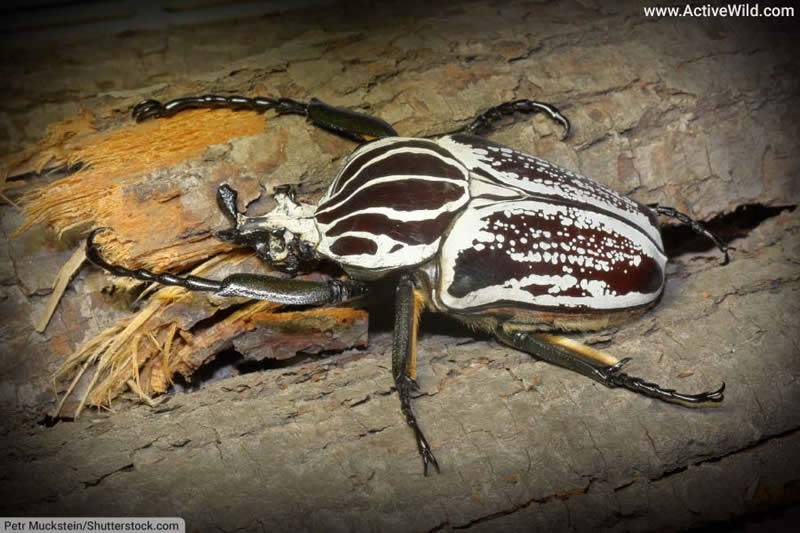
- Genus: Goliathus
- Type of animal: Insect
- Family: Scarabaeidae
- Where found: Africa
- Conservation status: Unassessed
The five species of Goliath beetles, which together make up the genus Goliathus, are the world’s largest insects. The largest of these African beetles grow up to 11 cm / 4.33 inches in length, and their larvae can weigh up to 100 grams (3.5 oz.).
Goliath beetles are found in tropical forests in Africa.
Discover More with Active Wild
Discover more about insects on this page: Insects – The Ultimate Guide
You can see more African animals on this page: African Animals List with Pictures and Facts
Goliath Birdeater
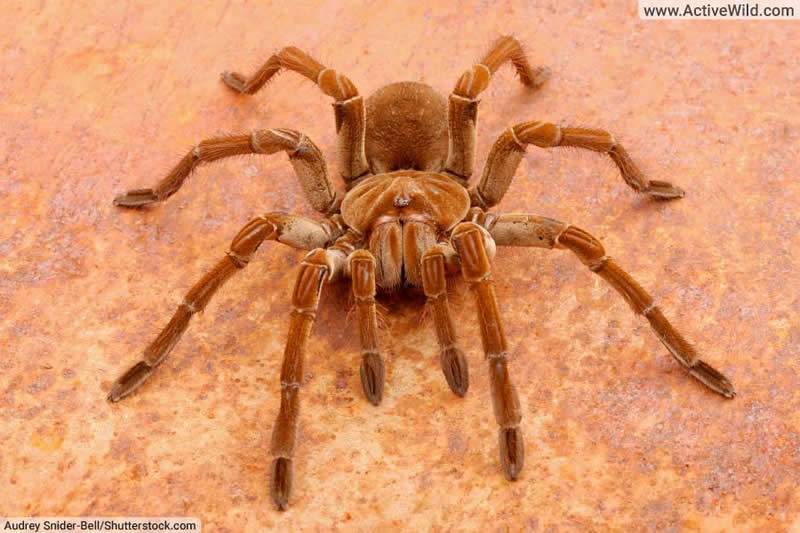
- Scientific name: Theraphosa blondi
- Type of animal: Arachnid
- Family: Theraphosidae
- Where found: South America
- Conservation status: Unassessed
The goliath birdeater is the world’s largest spider in both weight and length, although the giant huntsman spider Heteropoda maxima has a larger leg span. The goliath birdeater is a member of the tarantula family, Theraphosidae.
The goliath birdeater is found in the rainforests of South America. Despite its name, the spider rarely preys on birds. Instead, it mainly hunts earthworms and toads, but will also eat many other types of small animal. Its bite is venomous, but generally not harmful to humans.
Discover More with Active Wild
Discover more about spiders on this page: Is a Spider an Insect?
Find out more about arachnids on this page: Arachnids – The Ultimate Guide
You can see more rainforest animals on this page: Rainforest Animals List with Pictures & Facts
Goose
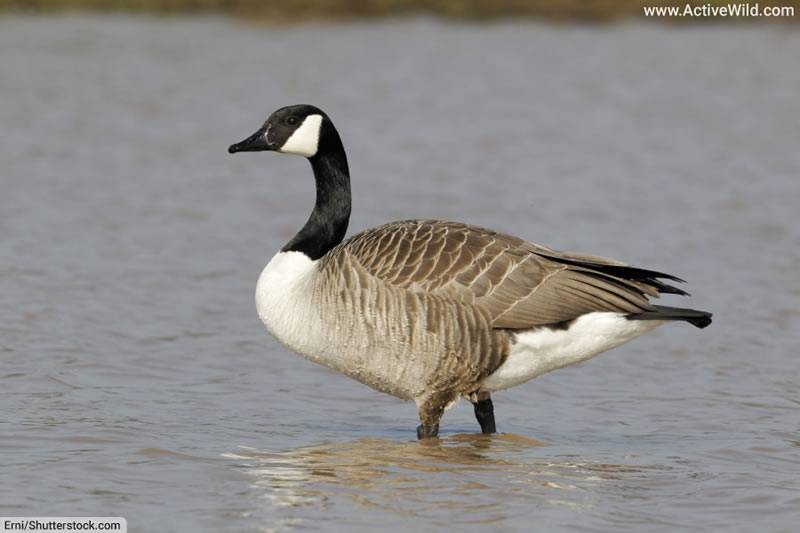
- Type of animal: Bird
- Order: Anseriformes
- Where found: All continents except Antarctica
Geese, together with ducks and swans, belong to the family Anatidae. Due to heavy hybridization, it is unclear exactly how many goose species exist.
The collective noun for a group of geese is a “gaggle”.
All wild goose species are monogamous (they mate for life). Domestic geese, however, exhibit polygamy, which is convenient for breeders who raise the birds for commercial purposes. A female goose incubates her eggs for 22 – 40 days while the male stands guard next to her.
Geese are extremely territorial, especially during the breeding season and while nesting. For this reason, geese make good “guard dogs”, honking loudly when strangers approach.
All geese species are omnivorous, but plant matter makes up the bulk of their diet.
Discover More with Active Wild
Find out more about birds on this page: Birds – The Ultimate Guide
Discover different types of birds on this page: Types of Birds with Pictures & Facts
Gopher
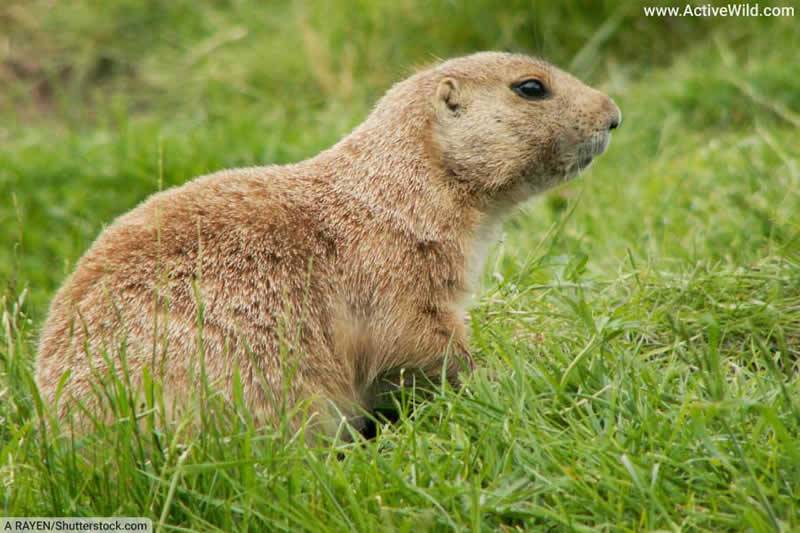
- Type of animal: Mammal
- Order: Rodentia
- Where found: North and Central America
Gophers are small, solitary, fossorial (burrowing) rodents in the family Geomyidae.
41 gopher species are currently recognized. All are herbivorous, feeding mostly on the roots of plants.
Gophers are also commonly referred to as “pocket gophers” due to their large, “pocket-like” fur-lined cheek pouches, in which the rodents store surplus food.
Gophers are excellent diggers, and have several adaptations for an underground, burrowing existence. These include small eyes and ears, and powerful forelimbs equipped with sturdy claws.
Discover More with Active Wild
Discover more about rodents on this page: Rodents – The Ultimate Guide
You can see more North American animals on this page: North American Animals List with Pictures & Facts
Gorilla
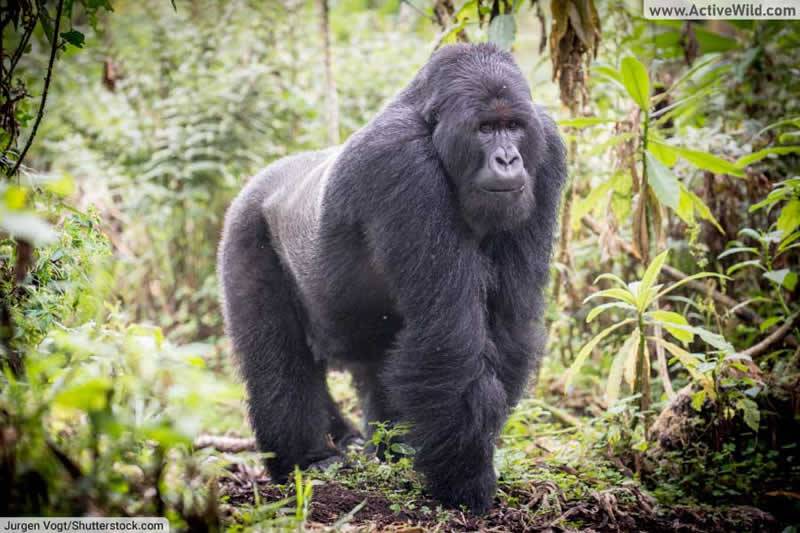
- Scientific name: eastern gorilla: Gorilla beringei; western gorilla: Gorilla gorilla
- Type of animal: Mammal
- Family: Hominidae
- Where found: Africa
- Conservation status: Critically Endangered
There are two gorilla species: the eastern gorilla and the western gorilla. Both are critically endangered.
Gorillas are members of the “great ape” family, Hominidae. This group also includes orangutans, chimpanzees and humans. Gorillas live in African rainforests
The eastern gorilla is slightly larger than its western cousin, making it not just the largest living hominid, but also the largest living primate.
Both gorilla species has two subspecies. The eastern gorilla’s subspecies are the eastern lowland gorilla and mountain gorilla; the western gorilla’s subspecies are the Western lowland gorilla and the Cross River gorilla.
Discover More with Active Wild
Discover more about the gorillas on this page: Gorilla Facts
Discover more about primates on this page: Primates – The Ultimate Guide
You can see more African animals on this page: African Animals List with Pictures and Facts
Grasshopper
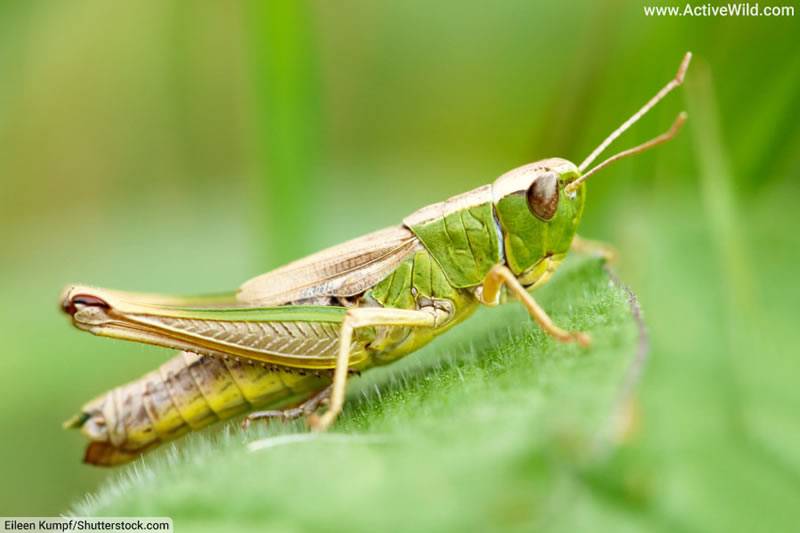
- Type of animal: Insect
- Order: Orthropoda
- Where found: Worldwide except the Arctic and Antarctica
Grasshoppers are jumping insects belonging to the suborder Caelifera. There are around 11,000 known grasshopper species and likely many more still to be discovered.
Although grasshoppers occur in a wide variety of habitats, they occur in the largest numbers in tropical areas. All known species are herbivorous.
The largest species of grasshopper is the “hedge grasshopper”, an Australian species that can reach a length of 9 cm / 3.5 in.
Most grasshopper species can jump, on average, 20 times their length and 10 times their height. This is accomplished with the powerful muscles found on the insects’ enlarged hind legs.
Discover More with Active Wild
Discover more about insects on this page: Insects – The Ultimate Guide
Gray Fox
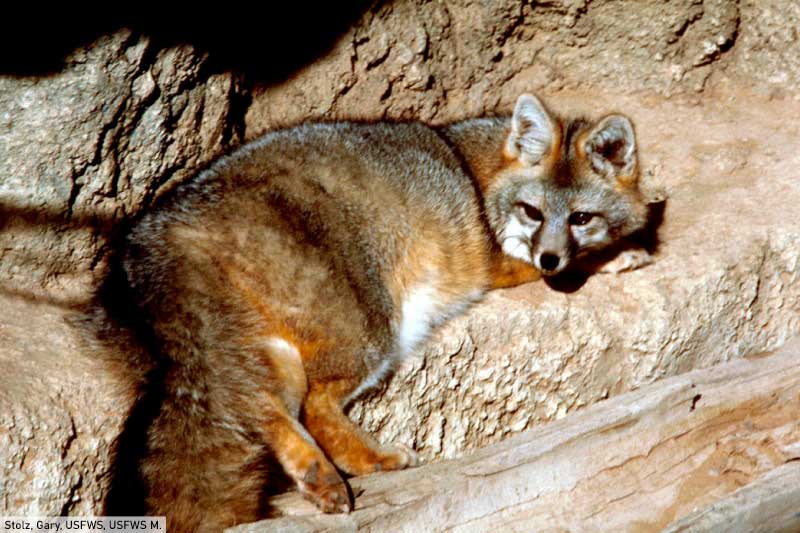
- Scientific name: Urocyon cinereoargenteus
- Type of animal: Mammal
- Family: Canidae
- Where found: North and Central America, Colombia and Venezuela
- Conservation status: Least Concern
The gray fox is a medium sized canid (member of the dog family, Canidae) that can be differentiated from other fox species by its relatively short legs and elongated body. It has reddish fur around its neck, legs and ears, while the rest of the body is varying shades of gray.
Solitary for most of the year, the gray fox forms monogamous pairs during the breeding season. Both parents are highly invested in the care of their young and will stay together until the pups are weaned.
The gray fox is the only fox species with retractable claws. This unique adaptation helps the fox climb trees; a useful skill for evading terrestrial predators such as coyotes.
An omnivorous and opportunistic feeder, the gray fox will eat invertebrates, small mammals, fruits, birds and carrion. It buries any surplus food it obtains.
Discover More with Active Wild
Discover more about the gray fox on this page: Gray Fox Facts
You can see more North American animals on this page: North American Animals List
Gray Reef Shark / Grey Reef Shark
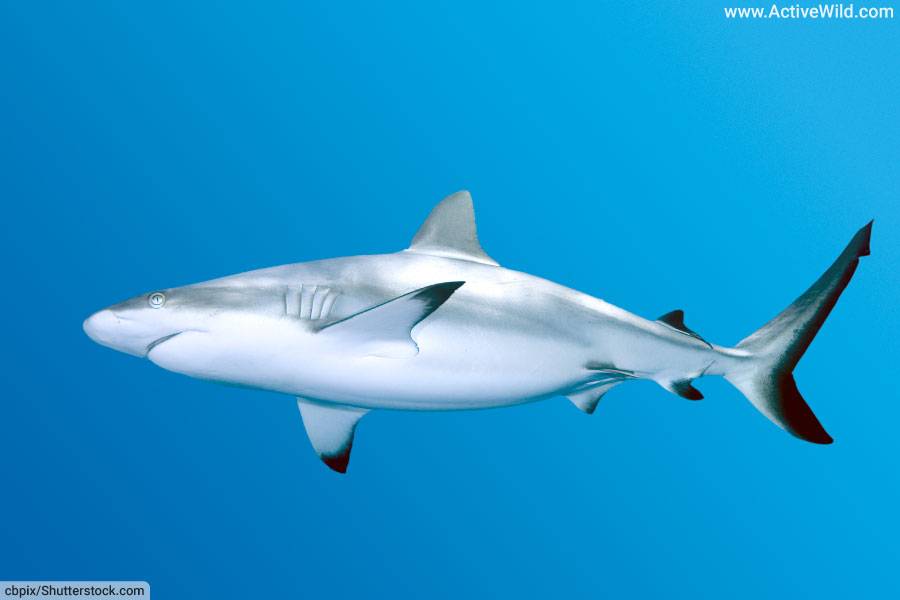
- Scientific name: Carcharhinus amblyrhynchos
- Type of animal: Cartilaginous fish
- Family: Carcharhinidae
- Where found: Indian and Pacific oceans
- Conservation status: Endangered
The gray reef shark / grey reef shark is a member of the requiem shark family, Carcharhinidae. It is found in shallow tropical and subtropical waters. It rarely exceeds 2 m / 6.56 ft. in length, and is well under half the size of the largest requiem shark, the tiger shark.
The gray reef shark is usually found close to reefs at depths of no more than 280 m / 918.7 ft., but is occasionally encountered in deeper waters in the open ocean.
A social species, the gray reef shark forms schools during the day, but hunts alone at night.
The gray reef shark is endangered and its population is decreasing, mainly due to overfishing. The species is often caught as accidental bycatch in fisheries targeting other species.
Discover More with Active Wild
You can see more sharks on this page: Types Of Sharks – Pictures & Facts
Learn more about sharks: Fun Facts on Sharks
Discover more amazing ocean animals on this page: Ocean Animals
Discover more about fish on this page: Fish – The Ultimate Guide
Gray Seal / Grey Seal
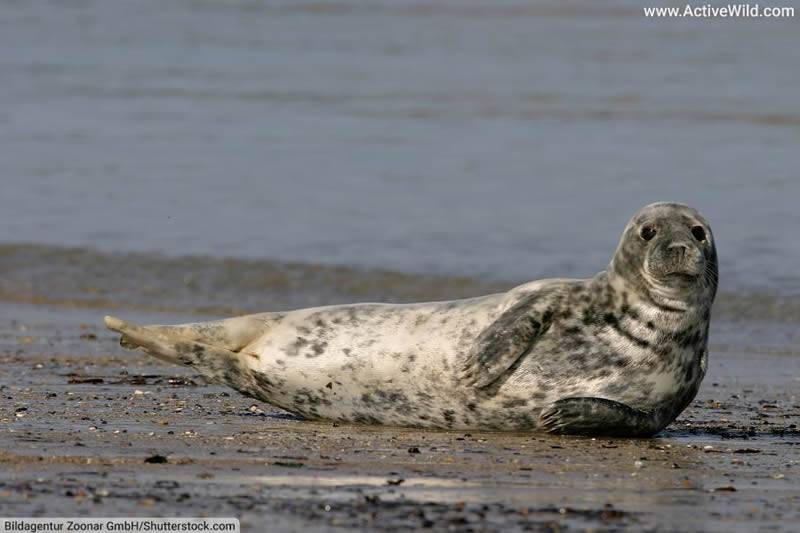
- Scientific name: Halichoerus grypus
- Type of animal: Mammal
- Family: Phocidae
- Where found: (North) Atlantic ocean
- Conservation status: Least Concern
The gray seal is a large seal found on rocky coasts and secluded islands on both sides of the Atlantic Ocean. The species displays sexual dimorphism in both size and coat pattern. The male is almost twice the size of the female, reaching a weight of up to 399 kg / 880 lbs. It is dark grey with silver spots, while the female is usually silver with scattered small black spots.
The species’ scientific name, Halichoerus grypus means: “hooked-nose pig of the sea” and comes from the distinctive shape of the male seal’s nose.
The grey seal is an opportunistic feeder, whose sight and hearing are substantially better underwater than they are on land. The species displays social feeding patterns that efficiently reduce the opportunity for prey to escape, thereby increasing the overall success of all individuals in a group.
Discover More with Active Wild
Find out more about the different types of mammals on this page: Types of Mammals
Discover more amazing ocean animals on this page: Ocean Animals
Great Blue Heron
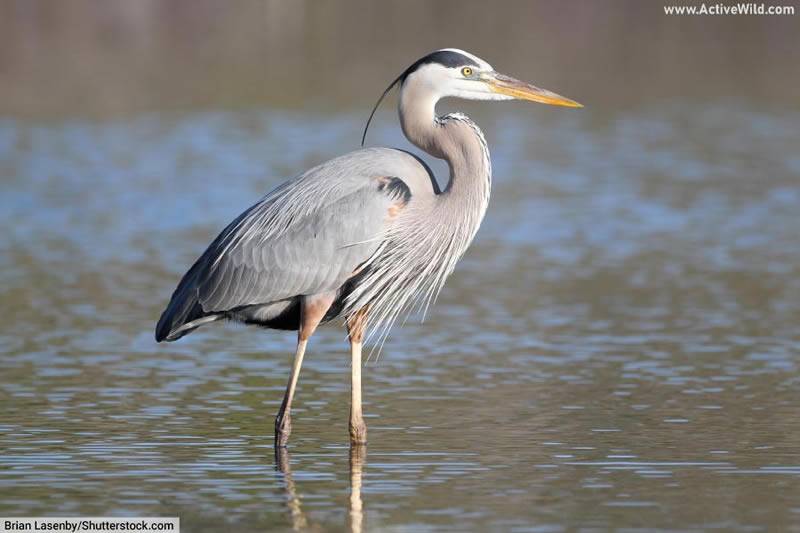
- Scientific name: Ardea herodias
- Type of animal: Bird
- Family: Ardeidae
- Where found: North and Central America, Galápagos and the Caribbean
- Conservation status: Least Concern
The great blue heron is North America’s largest heron species. It reaches a length of up to 137 cm / 53.9 in. and has an impressive, 1.8 m / 5.9 feet wingspan. Its upperparts are a grey-blue color, although all-white birds are found in Florida.
The great blue heron is always found close to bodies of water, and uses tall trees for resting and nesting. It is known to nest as high up as 21 m / 69 feet off the ground.
Like all herons, the great blue heron is a tall bird with long legs, a long neck and a sharp beak.
The bird’s strictly carnivorous diet consists mainly of fish, although the heron will also eat amphibians, invertebrates and even small mammals and birds.
Discover More with Active Wild
Find out more about birds on this page: Birds – The Ultimate Guide
Discover different types of birds on this page: Types of Birds with Pictures & Facts
Great Dane

- Scientific name: Canis lupus familiaris
- Type of animal: Mammal
- Family: Canidae
- Where found: Worldwide
- Conservation status: Domestic
The great Dane is a breed of dog that originated in Germany around 400 years ago. Initially bred as a hunting dog capable of taking down wild boars, today the great Dane is regarded as a gentle giant and a good family dog. It will, however, become very protective of its family, thus making it a great guard dog, too.
This dog is aptly named, with an average height of 81 cm / 32 in. at the shoulder and a weight of around 80 kg / 175 lbs.
The current record holder for “world’s tallest dog” is a great Dane named Zeus, who was 1.046 m / 3 ft. 5.18 in tall.
With an average lifespan of 7 – 10 years, the great Dane has a shorter life expectancy than most dog breeds.
Discover More with Active Wild
You can find out more about dogs on this page: Dog Facts
Discover every species in the dog family on this page: Dog Species List with Pictures & Facts
Great Hammerhead Shark
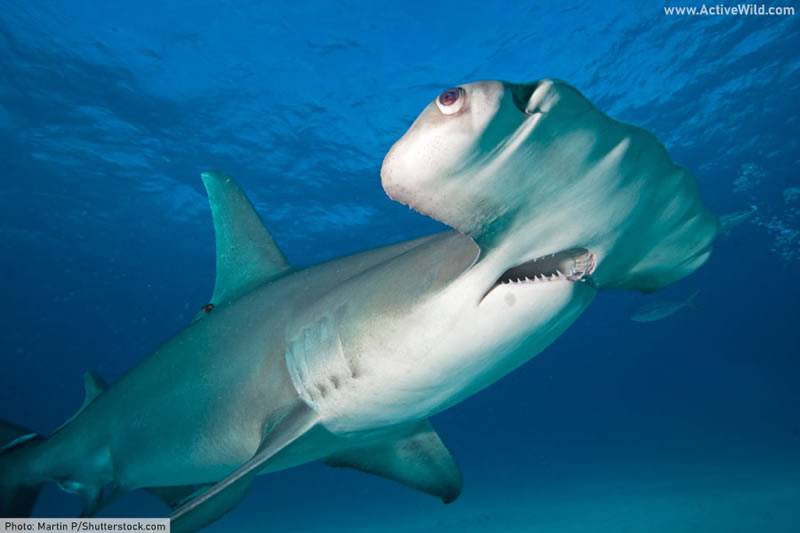
- Scientific name: Sphyrna mokarran
- Type of animal: Fish
- Family: Sphyrnidae
- Where found: temperate waters worldwide
- Conservation status: Critically Endangered
The great hammerhead shark is the largest of the 10 recognized species of hammerhead shark. This predatory fish, which reaches lengths of over 6 meters (20 ft.), is found in temperate waters worldwide.
The great hammerhead shark’s hammer-shaped head is known as a “cephalofoil”. The cephalofoil gives an improved field of vision, enabling the shark to see above and below it.
The shark’s cephalofoil also provides a wide area for the shark’s electroreceptors. These organs enable the shark to sense the electrical fields produced by the muscles of its prey.
Discover More with Active Wild
Discover more about the great hammerhead shark on this page: Great Hammerhead Shark Facts
You can see more sharks on this page: Types Of Sharks – Pictures & Facts
Learn more about sharks: Fun Facts on Sharks
Discover more about fish on this page: Fish – The Ultimate Guide
Great White Shark

- Scientific name: Carcharodon carcharias
- Type of animal: Fish
- Family: Lamnidae
- Where found: Oceans worldwide
- Conservation status: Vulnerable
The fearsome great white shark is the world’s largest predatory fish. Found in every ocean, the great white shark is an apex predator, sitting at the top of the food chain wherever it is found.
Only the killer whale (Orcinus orca) poses a potential threat to the great white shark, but altercations between these two apex predators are rare.
You can find out more about the great white shark on this page: Great White Shark Facts
Discover More with Active Wild
Discover more about the great white shark on this page: Great White Shark Facts
You can see more sharks on this page: Types Of Sharks – Pictures & Facts
Learn more about sharks: Fun Facts on Sharks
Discover more amazing ocean animals on this page: Ocean Animals
Greater Flamingo
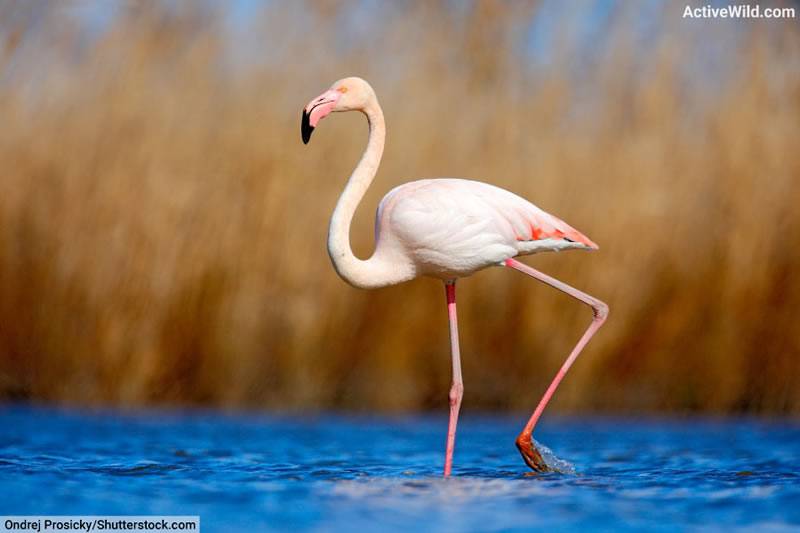
- Scientific name: Phoenicopterus roseus
- Type of animal: Bird
- Family: Phoenicopteridae
- Where found: Africa, Asia, Europe
- Conservation status: Least Concern
The greater flamingo is the largest and most widespread of the six recognized species in the flamingo family, Phoenicopteridae.
This distinctive bird is found in Africa, Asia and southern Europe. Like all flamingos, it feeds by filtering food out of the water using hair-like structures in its bill.
The greater flamingo’s pink color comes from chemicals contained in the food that it eats. The collective noun for a group of flamingos is “flamboyance”.
Discover More with Active Wild
Discover more about the greater flamingo on this page: Greater Flamingo Facts
Find out more about birds on this page: Birds – The Ultimate Guide
Discover different types of birds on this page: Types of Birds with Pictures & Facts
Green Anaconda
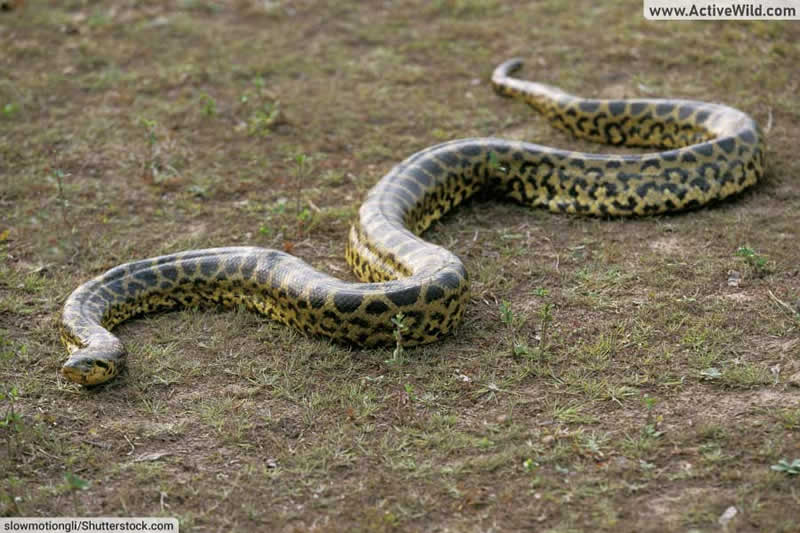
- Scientific name: Eunectes murinus
- Type of animal: Reptile
- Family: Boidae
- Where found: South America
- Conservation status: Least Concern
The green anaconda reaches lengths of 10 – 12 m / 32.8 – 39.4 feet and weights of up to 250 kg / 551 lbs. The species is the world’s largest snake in terms of weight, but not in length (the reticulated python is even longer). Females are larger than males.
This fearsome apex predator is semiaquatic and found in lakes and rivers throughout much of northern and central South America.
The green anaconda ambushes its prey from the water. The snake will feed on almost anything it can catch, including deer, large rodents, fish, turtles, birds, and caimans.
Due to its slow metabolism, the green anaconda can go several months without food after a large meal.
Discover More with Active Wild
You can find out more about green anacondas on this page: Green Anaconda Facts
Discover more about the world of snakes: Snake Facts
You can see more amazing snakes on this page: Types of Snakes
You can find out more about reptiles on this page: Reptiles – The Ultimate Guide
Greenland Shark
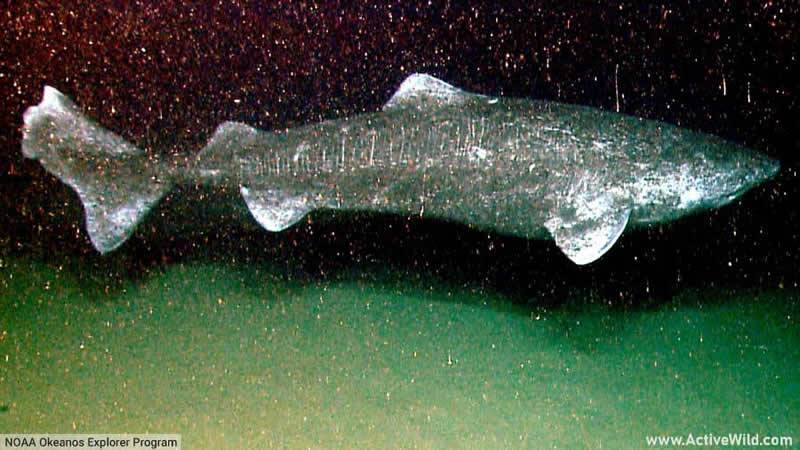
- Scientific name: Somniosus microcephalus
- Type of animal: Fish
- Family: Somniosidae
- Where found: Arctic and sub-Arctic waters.
- Conservation status: Vulnerable
The Greenland shark is a large, mysterious species found in both the North Atlantic and Arctic Oceans. It is often found at great depths, but moves to shallower waters during the winter. The species is one of the largest sharks, growing to a similar size as the great white shark.
With an estimated lifespan of between 250 and 500 years, the Greenland shark is the longest-lived of all vertebrates.
Discover More with Active Wild
Discover more about the Greenland shark on this page: Greenland Shark Facts
You can see more sharks on this page: Types Of Sharks – Pictures & Facts
Learn more about sharks: Fun Facts on Sharks
Discover more amazing ocean animals on this page: Ocean Animals
Grey Mouse Lemur
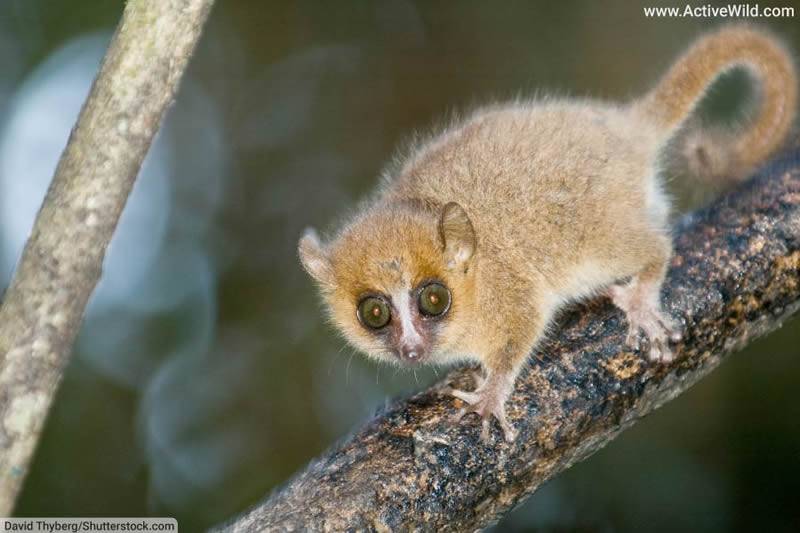
- Scientific name: Microcebus murinus
- Type of animal: Mammal
- Family: Cheirogaleidae
- Where found: Madagascar
- Conservation status: Least Concern
Despite being the largest of the 25 or so mouse lemurs, the grey mouse lemur is one of the world’s smallest primates.
The species is found only in the dense forests of the African island country Madagascar, where it spends most of its life in the trees.
This nocturnal species rests in nests during the day. Males nest alone or in pairs, females in groups of around 15 individuals.
The grey mouse lemur is an omnivore whose main source of animal protein comes from insects. It will occasionally eat some small reptiles and amphibians.
This species is abundant throughout its home range but, like many Madagascan species, is threatened by deforestation.
Discover More with Active Wild
Discover more about primates on this page: Primates – The Ultimate Guide
You can see more African animals on this page: African Animals List with Pictures and Facts
Grizzly Bear
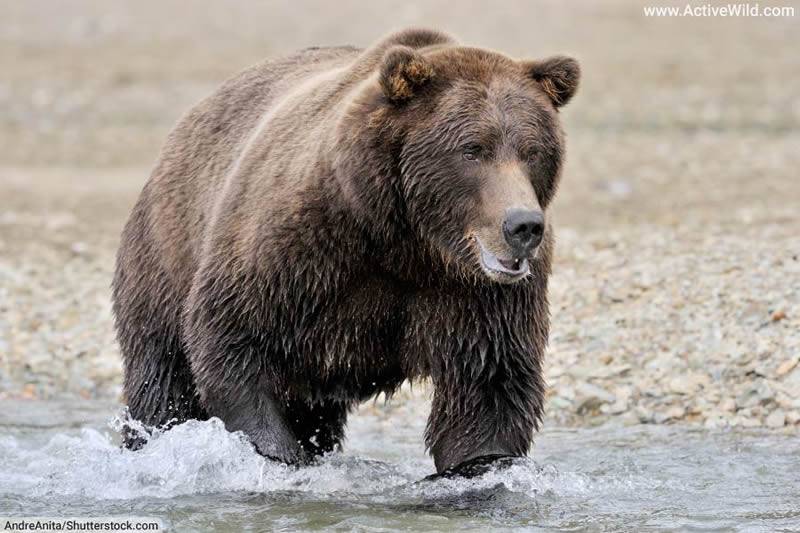
- Scientific name: Ursus arctos horribilis
- Type of animal: Mammal
- Family: Ursidae
- Where found: North America
- Conservation status: Least Concern
The grizzly bear is a North American subspecies of brown bear. It is an apex predator, famed for its strength and hunting ability, as well as for its bad temper.
Salmon making their way upriver to spawn is an important food for Canadian and Alaskan grizzlies. The largest grizzlies are found where salmon is readily available, and bears fight one another for access to the best fishing spots.
Discover More with Active Wild
You can find out more about the grizzly bear on this page: Grizzly Bear Facts
Discover more about bears on this page: Bear Facts
See every bear species on this page: Types of Bears – Pictures & Facts on EVERY bear species
Guinea Pig
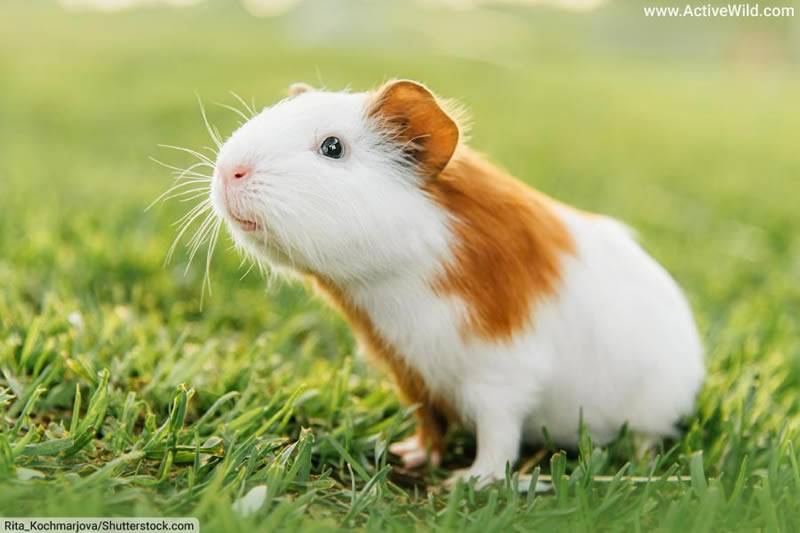
- Scientific name: Cavia porcellus
- Type of animal: Mammal
- Family: Caviidae
- Where found: Worldwide
- Conservation status: Domestic
The guinea pig is a rodent first domesticated in South America over 3,000 years ago, originally as a source of food. After the Spanish colonization of South America, the guinea pig began to be selectively bred as a household pet, and eventually became globally distributed.
There are five wild guinea pig species in different parts of South America, four of which are listed by the IUCN as species of least concern. The Santa Catarina’s guinea pig is listed as critically endangered and it is only found in a small area of Brazil.
The guinea pig is one of the largest pet rodents, weighing between 0.5 – 1.5 kg / 1.1 – 3.3 lbs. With a lifespan of up to 14 years, it is also one of the longest-lived.
The highly-social nature of the Guinea pig can lead to problems; males establish social hierarchies and can get very aggressive with each other.
Discover More with Active Wild
Discover more about rodents on this page: Rodents – the Ultimate Guide
Gyrfalcon
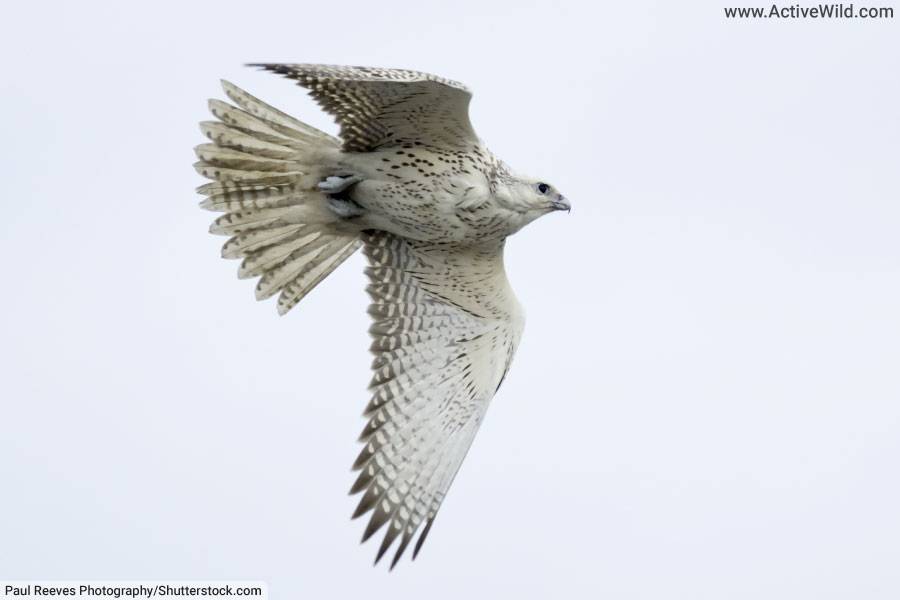
- Scientific name: Falco rusticolus
- Type of animal: Bird
- Family: Falconidae
- Where found: The Arctic
- Conservation status: Least Concern
The gyrfalcon is the world’s largest falcon. It breeds in the Arctic, but ventures further south in the winter. The gyrfalcon’s plumage varies depending on where it is found. Those that live in Greenland are largely white, with gray-white wings. Those from other areas can be grey-brown in color.
The gyrfalcon captures its prey both in the air and on the ground. Male and female gyrfalcons are known to hunt cooperatively to exhaust their prey.
Discover More with Active Wild
Find out more about birds on this page: Birds – The Ultimate Guide
Discover different types of birds on this page: Types of Birds with Pictures & Facts
You can see more Arctic animals on this page: Arctic Animals List with Pictures & Facts
Animals That Start With G: Conclusion
We hope that you’ve discovered some interesting animals with names beginning with G on this page.
You can discover more animals in our A to Z animals section by clicking on the letters below…
The post Animals That Start With G: List With Pictures & Interesting Facts appeared first on Active Wild.


























